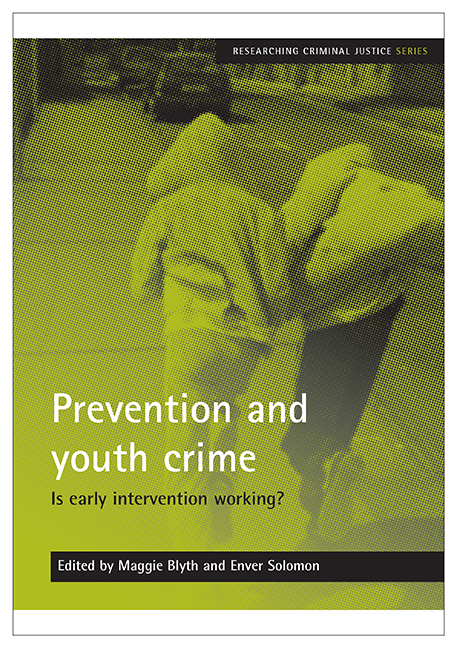Book contents
- Frontmatter
- Contents
- Foreword
- Acknowledgements
- List of abbreviations
- Notes on contributors
- Introduction
- 1 Integrated or targeted youth support services: an essay on ‘prevention’
- 2 Intervening in gang-affected neighbourhoods
- 3 Family intervention projects and the efficacy of parenting interventions
- 4 Early intervention and prevention: lessons from the Sure Start programme
- 5 Attachment research and the origins of violence: a story of damaged brains and damaged minds
- 6 Early intervention in the youth justice sphere: a knowledge-based critique
- 7 European perspectives on prevention
- Conclusion
6 - Early intervention in the youth justice sphere: a knowledge-based critique
Published online by Cambridge University Press: 25 March 2023
- Frontmatter
- Contents
- Foreword
- Acknowledgements
- List of abbreviations
- Notes on contributors
- Introduction
- 1 Integrated or targeted youth support services: an essay on ‘prevention’
- 2 Intervening in gang-affected neighbourhoods
- 3 Family intervention projects and the efficacy of parenting interventions
- 4 Early intervention and prevention: lessons from the Sure Start programme
- 5 Attachment research and the origins of violence: a story of damaged brains and damaged minds
- 6 Early intervention in the youth justice sphere: a knowledge-based critique
- 7 European perspectives on prevention
- Conclusion
Summary
When a youth commits a crime and we let him go, then the probability that he will do another crime is actually lower than if we’d punished him. (Von Liszt, 1893)
[W]e have ensured that young offenders are now much more likely to be brought to justice through significant transformations to the Youth Justice System. (HM Government, 2008, para 2)
Introduction: ‘risk’, prevention and early intervention
In many respects, modes of intervention that ostensibly aim to prevent or ameliorate ‘risk’ play an increasingly significant role in shaping, defining and legitimising modern forms of child and youth governance. The multiple and fluid meanings routinely attached to the concept of ‘risk’, however, are not always clear. Some children and young people are conceived as being particularly susceptible to ‘risk’, implying constructions of vulnerability and invoking the imperatives of protection and safeguarding (as in modern child welfare discourse; see, for example, DCSF, 2007). Conversely, different constituencies of the young are deemed to comprise a primary source of ‘risk’, implying a threatening or menacing presence and invoking regulatory and corrective priorities (as in contemporary youth justice discourse; see, for example, HM Government, 2008).
Such binary conceptualisations inevitably tend to oversimplify (Goldson, 2004). Nonetheless, they each provide rationales for various forms of early intervention, greater levels of adult supervision, more intensive patterns of regulation and surveillance and, ultimately, circumscribed access to public spaces for children and young people. In the first instance, a variety of disparate factors – ranging from concerns regarding ‘stranger-danger’, predatory adults and paedophilia, through to the consequences of increasing road traffic, expanding car-dependent lifestyles, the diminishing quantity and quality of public facilities (parks, adventure playgrounds, youth clubs), the growth of home-based entertainment, organised indoor leisure activities and major developments in (and the proliferation of) information technology and communication systems – have combined to limit the visibility, activity and social interaction of children and young people in the public sphere. Alternatively, constructions of ‘anti-social’, disorderly and offending youth, together with an increasing array of dispersal powers, civil injunctions and criminal orders to which they have been exposed in recent years, have served to limit their movement, inhibit their public presence and subject them to greater levels of restriction, regulation and control.
- Type
- Chapter
- Information
- Prevention and Youth CrimeIs Early Intervention Working?, pp. 89 - 104Publisher: Bristol University PressPrint publication year: 2008



